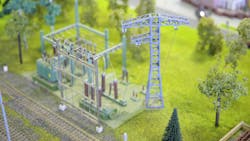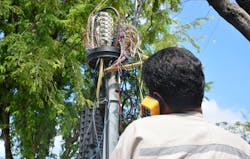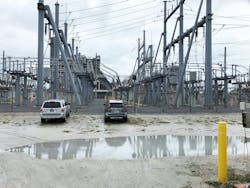Editor's Note: T&D World Live will feature Delivering the Real Zero Grid, a session covering the topics addressed in this article. The event will take place Oct. 1-3, 2024, in Atlanta, Georgia. Visit events.tdworld.com to register.
Regulators, politicians and customers seem to be reaching a consensus. The future of electricity will have a net zero, and eventually, real zero carbon content. We could get there perhaps even by 2050.
There are many ways to measure these goals, so definitions are important. Net zero energy is defined as the generation of electricity from non-carbon generating resources like nuclear, hydro, wind and solar with allowances for government approved offsets and credits. Real zero energy does not include the offsets and credits. Net zero or real zero energy by 2050 has dramatic implications on the current planning, design, operations and maintenance of the electric transmission and distribution grid that delivers our energy.
Aiming for 2050
Real zero energy will be achieved alongside massive electrification of mobility, space conditioning and commercial and industrial (C&I) processes. Some predict doubling or tripling the current national peak generating capacity of 1.3 million MW. Substation and telecommunications equipment must be upgraded in capacity and capability to support massive electrification. We will need underground distribution for the reliability and resilience needed for small scale distributed energy resources (DER) that support massive electrification.
Real zero energy will require new nuclear and existing big hydro to provide base load spinning mass for system stability and some degree of fast generation ramping with hydro and pumped storage where available. Otherwise, ramping will be conducted with new and existing high efficiency natural gas turbines. This will require upgrades for existing transmission capacity to support the new nuclear, huge amounts of remote utility-scale renewables, and existing big hydro. Transmission capacity will be developed using existing rights of way with dynamic line rating (DLR), advanced composite conductors, and high voltage direct current (HVDC) conversions.
We can also leverage new “wild card” technology toward this goal. Artificial intelligence (AI) may plan and design the T&D system. Sensors on everything will provide a rich, secure data source for AI algorithms that efficiently deliver the cleanest and most affordable source of generation while enhancing safety, reliability and resiliency of the grid. Advancements in material sciences will lead to superior storage media, working fuel cells, 3D design and printing, robots and more.
Massive Electrification
Electrifying the economy claims many benefits. Electrification brings communities economic development, better transportation and emerging technologies across a broad spectrum of services. Electricity is safe, with design codes and best practices established. Electricity is reliable. Across the U.S., the power grid is 99.97% reliable, according to the Galvin Electricity Initiative. Electricity is relatively inexpensive. According to the U.S .Commerce Department, electricity represents less than 2% of annual household spending.
Finally, electricity is getting cleaner. As of February 2023, the U.S. has nearly 1.3 million MW of generation capacity, according to the American Public Power Association (APPA). The largest fuel source for this capacity is natural gas (43.9%), followed by coal (17%). Wind, nuclear, and hydro together account for more than one-third of capacity and solar has added than 38,000 MW since 2020.
Substations and Communications
Substations will need to be bigger and telecommunications more robust. Data scientists, engineers and planners must prioritize and schedule the upgrade and doubling of capacity of existing and future substations and strongly consider building a private broadband telecommunications network with a dedicated utility spectrum.
Urban open-air substations that occupy all the available real estate must be converted to gas insulated switchgear (GIS) substations and suburban or rural substations with adequate real estate must have their ultimate build-out doubled in scope. Installing gates and fences, ground grids, conduit systems, control house structures and security measures for the ultimate build-out should be evaluated. Load growth due to massive electrification and data centers, high tech manufacturing, hydroponics and cryptocurrency mining occur in hard to predict parts of the service territory and require rapid deployment of reliable and redundant electric service.
Going Underground
Much of the real zero power grid must be built underground. Undergrounding offers several advantages compared with overhead lines including reduced vulnerability to weather events like floods, lightning, hurricanes and wildfires. By eliminating the impact of future fires, storm conditions and reducing other potential outages caused by falling tree limbs or vegetation contact, car struck poles, birds and rodents, mylar balloon impacts, ground line wood rot and others, undergrounding contributes to a much more reliable and resilient electric grid.
The industry defines reliability with outage duration and frequency while resilience is defined as the ability to withstand a high impact, low probability (HILP) event with little or no customer outage. Reliability is measured in outage minutes and resilience is typically measured in days. Undergrounding provides a much more resilient system and is the level of performance that real zero energy will require.
More Power
Our industry needs nuclear power to achieve ambitious real zero goals. The Southern Company has commissioned the 1100 MW Plant Vogtle Unit 3 and is working on commissioning Unit 4 with great expense and schedule overruns. But they did it.
The most promise for nuclear in the U.S. is held in small modular reactors (SMR) or advanced reactors planned by PacifiCorp. Nuclear is a key part of PacifiCorp’s 2023 Integrated Resource Plan (IRP).
Large hydroelectric generation from existing dams particularly in the West and New York State represent nearly 6% of the total generating capacity in the US and about 38% of the renewable generation.
Hydropower and pumped storage resources will continue to be part of a clean energy mix for decades to come.
A Grid to Match
Even with abundant local DERs the real zero grid will need a robust transmission system. A megatrend in our industry is realizing capacity from existing transmission rights of way. Routing and permitting new major transmission corridors can take decades as evidenced by SunZia, TransWest Express and some of the larger lines in California. In New England, the Northern Pass Transmission Project applied to the DOE for a presidential permit to construct, operate, maintain, and connect an HVDC line in October of 2010. Northern Pass failed to get approvals and was replaced by the yet-unfinished New England Clean Energy Connect. New long-distance transmission will likely be HVDC and will be sited in railroad and highway ROWs to expedite routing and permitting challenges. In these transportation corridors, the transmission will also likely be underground.
Dynamic line rating allows real-time monitoring and assessment of line capacity based on thermal capacity during prevailing weather and environmental conditions. Unlike traditional static line ratings, which are conservative and fixed or only seasonally adjusted, DLR accounts for conductor tension and temperature, air temperature, wind speed, solar radiation and humidity to determine safe operating limits of transmission more accurately. With static line ratings, lines are often underused during most conditions to prevent potential overheating, violations of minimum ground clearances, or long-term conductor damage during weather events. DLR will maximize available transmission capacity for the short run.
Several utilities across the world are having success in expanding capacity with advanced composite core conductors that allow more ampacity to flow through a same or smaller sized cross-section when compared to steel core conductors. Retro-fitting existing lines to increase capacity without changing structures is commonly done at American Electric Power. Likewise, NV Energy is retrofitting heavily loaded urban lines and is building some new transmission lines with advanced conductors that have more capacity to accommodate potential load growth due to electrification. Advanced conductors have distribution applications as well.
AI’s Impacts
There are different types of AI, ranging from simple rule-based systems to more complex machine learning algorithms that can learn and adapt over time. Like the human brain, AI functions around pattern recognition. As a child, we learn by using our five senses to communicate to our brain. Over time, our brain recognizes the look, feel, smell, sound or taste of an infinite number of people, places and things. With faster computers and sufficient data storage, a computer can do the same thing.
Ubiquitous data sensors can be used on the grid and on customer premises in several ways to maintain and improve safety, reliability and resiliency. Data sensors can monitor the system in real time, providing utilities with instant data that, once processed, can give a picture of infrastructure condition and performance. This can predict and identify issues or problems before they become serious and take proactive measures to maintain system health and reliability. Sensors spot wildfires, downed conductors, failing cables, voltage anomalies and faults in the T&D system. By leveraging the power of data, utilities can improve their operations and support the development of a real zero grid that continues to meet the needs of consumers and communities.
Wild Cards
Lithium-ion battery technology will be replaced with new storage technologies in the next decade. The critical rare earth elements that make lithium-ion batteries like nickel, lithium and cobalt are not sustainable in the long run. Hydrogen storage may be part of that solution.
Bio-fueled fuel cells or hydrogen fuel cells can generate electricity, providing a clean and efficient alternative to traditional fossil-fired power generation. Hydrogen from fuel cells can power electric vehicles, homes, schools and businesses. Bio-fueled fuel cells or hydrogen fuel cells can balance the electric grid by providing a flexible source of power that can respond quickly to changes in demand or supply. Hydrogen fuel cells can provide backup power during times of peak demand, reducing the need for fossil fuel-based peaking plants. Finally, hydrogen fuel cells can be part of a portfolio of generation, storage and demand side management tools used to successfully operate and maintain net zero energy buildings and eventually the real zero grid.
The digital twin is a multi-dimensional model or representation of a physical asset, infrastructure system or city that provides valuable information about asset location, cost, condition and performance. The digital twins are constantly updated from multiple human, robotic and sensory data sources. They are not a static three-dimensional model and can include dimensions for schedule, cost, ESG scoring and more.
The digital twin of the overhead and underground electric transmission and distribution system is a virtual replica of the physical system. It is a computer-based model that incorporates data from various sources, such as sensors, meters, robots and other monitoring equipment, to provide a detailed and accurate representation of the electric system. The digital twin can simulate various design scenarios such as the integration of distributed resources like renewables, storage, electric vehicles (EV) or fuel cells as data scientists, planners and engineers model and prioritize the development of the real zero grid.
The digital twin can assist operators with condition assessment and predictive analyses of asset condition as part of an asset management program or asset health center. This can help utilities optimize their asset management strategies and extend the life of their increasingly loaded substation equipment.
Three-dimensional printing construction may impact the T&D industry in several ways. 3D printing can create durable replacement parts on the jobsite for some equipment and potentially reduce downtime and repair costs. Plastic parts, panels or enclosures in substations or in manholes will be the starting point. As print feedstock metallurgy advances this opportunity will grow significantly and improve the ability to solve some critical path supply chain issues with a printed part rather than a long lead time part from a faraway factory. The real zero grid will need a supply chain that delivers parts and components rapidly, perhaps in real time.
Material science breakthroughs will give our industry superconducting technology that will be safe, reliable and affordable in the next decade. Replacing old underground high-pressure fluid filled transmission lines in heavy urban environments will be a perfect application. ComEd in Chicago has piloted this technology with reasonable success.
Utility companies operate in a rapidly evolving industry that faces technological advancements, changing customer demands, and regulatory shifts. Real zero energy has huge implications for the electric T&D industry.
Executives, planners and technical teams constantly look for innovative solutions that embrace new technologies, ideas, and approaches to enhance and continuously improve their operations, efficiency, and services to customers. The assumptions and ideas herein are an attempt to help the industry move forward and solve for the challenges of achieving real zero energy and the T&D grid to deliver it by 2050.
Mike Beehler P.E. ([email protected] ) is the chief opportunity officer for Mike Beehler & Associates LLC. He started his career designing and building transmission lines and substations for Tucson Electric Power and the Hawaiian Electric Co. and then spent more than 20 years designing T&D infrastructure and consulting on emerging trends at Burns & McDonnell. He has written, presented and consulted on reliability-centered maintenance, critical infrastructure protection and program management. In addition, he is a well-known industry writer and speaker on the early definition of the smart grid, 3-D and building information modeling applications in T&D, and development plans for smart cities. Most recently, he is sought for his strategic leadership and vision on the application of emerging technologies in changing business models to include the integration of distributed energy resources, augmented/virtual reality and artificial intelligence. He authored the book, The Science of the Sale: A New Paradigm of Thinking for Your Future. Beehler is a registered professional engineer in Arizona, Florida, Hawaii, Texas, Colorado, Kansas, Georgia and Alabama. He also is a Fellow in the American Society of Civil Engineers and a member of IEEE and CIGRE.
About the Author
Mike Beehler
Vice President
Mike Beehler P.E., ([email protected] ), is the national spokesperson for the Power Delivery Intelligence Initiative and the chief opportunity officer for Mike Beehler & Associates LLC. He started his career designing and building transmission lines and substations for Tucson Electric Power and the Hawaiian Electric Co. and then spent more than 20 years designing T&D infrastructure and consulting on emerging trends at Burns & McDonnell. He has written, presented and consulted on reliability-centered maintenance, critical infrastructure protection and program management. In addition, he is a well-known industry writer and speaker on the early definition of the smart grid, 3-D and building information modeling applications in T&D, and development plans for smart cities. Most recently, he is sought for his strategic leadership and vision on the application of emerging technologies in changing business models to include the integration of distributed energy resources, augmented/virtual reality and artificial intelligence. He authored the book, The Science of the Sale. Beehler is a registered professional engineer in Arizona, Florida, Hawaii, Texas, Colorado, Kansas, Georgia and Alabama. He also is a Fellow in the American Society of Civil Engineers and a member of IEEE and CIGRE.


